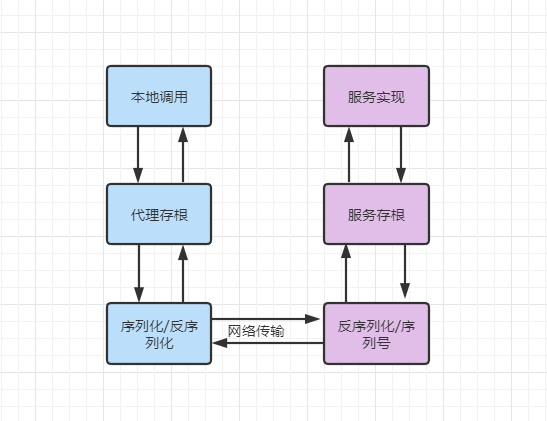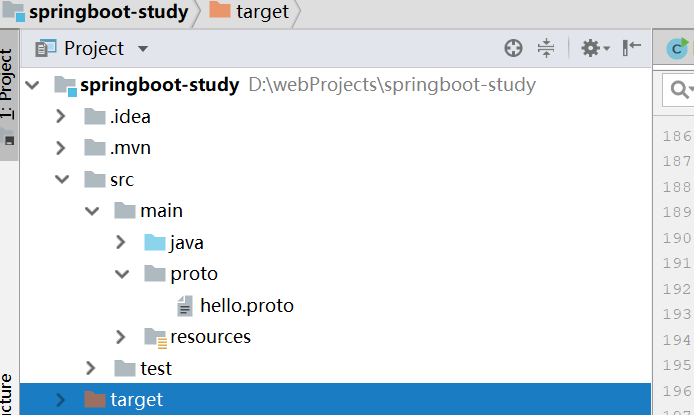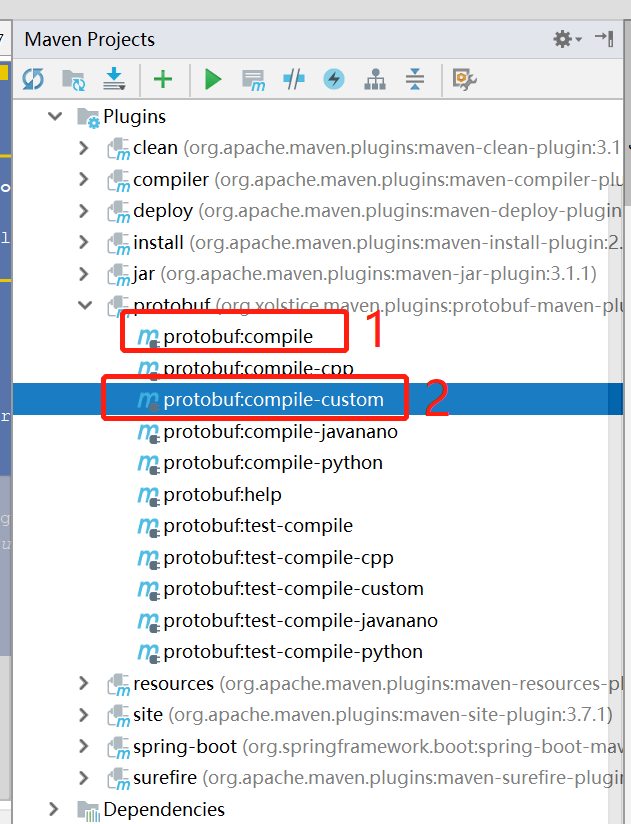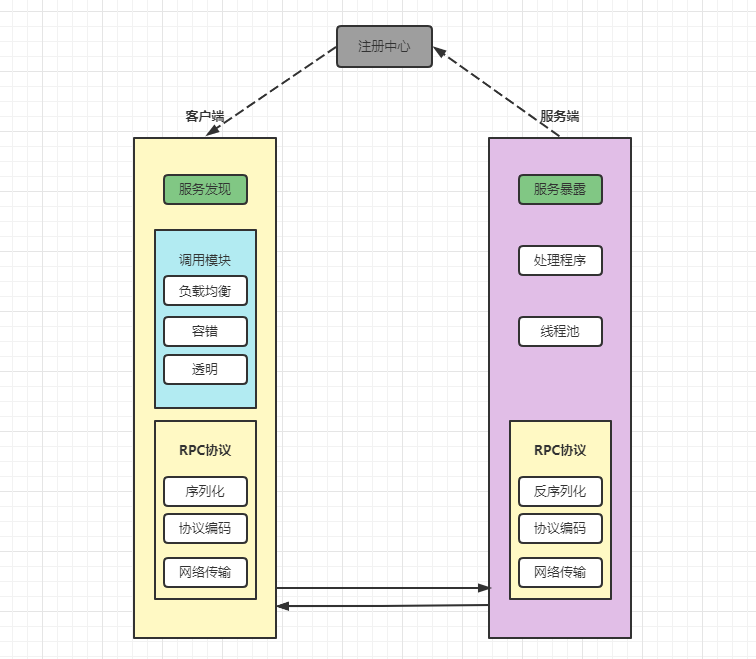RPC是什么?
RPC是远程过程调用(Remote Procedure Call)的缩写,简单的来说就是像调用本地方法一样调用远程方法。
RPC简化版原理:

RPC实现原理:
大概由如下几部分组成:
1. 设计
本地应用程序与远程应用程序,需要共享什么信息?
可以共享:POJO实体类定义、接口定义。当然还可以选择:WSDL/WADL/IDL
definitions>
<types>
definition of types........
</types>
<message>
definition of a message....
</message>
<portType>
definition of a port.......
</portType>
<binding>
definition of a binding....
</binding>
</definitions>
2. 代理
Java下,代理可以选择使用动态代理或者AOP实现。
3. 序列化
速度、空间对比图:

具体数据:

4. 网络传输
TCP/SSL/HTTP/HTTPS
5. 查找实现类
通过接口去查找服务端的实现类。一般是注册方式。将实现类注册到Spring的方式
Hessian、Thrift、gRPC
gRPC使用示例:
<dependency>
<groupId>io.grpc</groupId>
<artifactId>grpc-all</artifactId>
<version>${grpc-version}</version>
</dependency>
<build>
<plugins>
<plugin>
<groupId>org.xolstice.maven.plugins</groupId>
<artifactId>protobuf-maven-plugin</artifactId>
<version>0.5.0</version>
<configuration>
<!--
The version of protoc must match protobuf-java. If you don‘t depend on
protobuf-java directly, you will be transitively depending on the
protobuf-java version that grpc depends on.
-->
<protocArtifact>com.google.protobuf:protoc:3.5.0:exe:${os.detected.classifier}</protocArtifact>
<pluginId>grpc-java</pluginId>
<pluginArtifact>io.grpc:protoc-gen-grpc-java:${grpc-version}:exe:${os.detected.classifier}</pluginArtifact>
</configuration>
<executions>
<execution>
<goals>
<goal>compile</goal>
<goal>compile-custom</goal>
</goals>
</execution>
</executions>
</plugin>
</plugins>
<extensions>
<extension>
<groupId>kr.motd.maven</groupId>
<artifactId>os-maven-plugin</artifactId>
<version>1.4.1.Final</version>
</extension>
</extensions>
</build>
在src/main/proto目录下创建一个proto文件:

内容为:
syntax = "proto3";
option java_multiple_files = true;
option java_package = "io.grpc.examples.helloworld";
option java_outer_classname = "HelloWorldProto";
option objc_class_prefix = "HLW";
package helloworld;
// The greeting service definition.
service Greeter {
// Sends a greeting
rpc SayHello (HelloRequest) returns (HelloReply) {}
}
// The request message containing the user‘s name.
message HelloRequest {
string name = 1;
}
// The response message containing the greetings
message HelloReply {
string message = 1;
}
运行插件,生成java文件

编写server代码
package com.mmc.springbootstudy.grpc;
import io.grpc.Server;
import io.grpc.ServerBuilder;
import io.grpc.examples.helloworld.GreeterGrpc;
import io.grpc.examples.helloworld.HelloReply;
import io.grpc.examples.helloworld.HelloRequest;
import io.grpc.stub.StreamObserver;
import java.io.IOException;
public class HelloWorldServer {
private int port = 50051;
private Server server;
private void start() throws IOException {
server = ServerBuilder.forPort(port)
.addService(new GreeterImpl())
.build()
.start();
System.out.println("service start...");
Runtime.getRuntime().addShutdownHook(new Thread() {
@Override
public void run() {
System.err.println("*** shutting down gRPC server since JVM is shutting down");
HelloWorldServer.this.stop();
System.err.println("*** server shut down");
}
});
}
private void stop() {
if (server != null) {
server.shutdown();
}
}
// block 一直到退出程序
private void blockUntilShutdown() throws InterruptedException {
if (server != null) {
server.awaitTermination();
}
}
public static void main(String[] args) throws IOException, InterruptedException {
final HelloWorldServer server = new HelloWorldServer();
server.start();
server.blockUntilShutdown();
}
// 实现 定义一个实现服务接口的类
private class GreeterImpl extends GreeterGrpc.GreeterImplBase {
public void sayHello(HelloRequest req, StreamObserver<HelloReply> responseObserver) {
System.out.println("service:"+req.getName());
HelloReply reply = HelloReply.newBuilder().setMessage(("Hello: " + req.getName())).build();
responseObserver.onNext(reply);
responseObserver.onCompleted();
}
}
}
package com.mmc.springbootstudy.grpc;
import io.grpc.ManagedChannel;
import io.grpc.ManagedChannelBuilder;
import io.grpc.examples.helloworld.GreeterGrpc;
import io.grpc.examples.helloworld.HelloReply;
import io.grpc.examples.helloworld.HelloRequest;
import java.util.concurrent.TimeUnit;
public class HelloWorldClient {
private final ManagedChannel channel;
private final GreeterGrpc.GreeterBlockingStub blockingStub;
public HelloWorldClient(String host,int port){
channel = ManagedChannelBuilder.forAddress(host,port)
.usePlaintext(true)
.build();
blockingStub = GreeterGrpc.newBlockingStub(channel);
}
public void shutdown() throws InterruptedException {
channel.shutdown().awaitTermination(5, TimeUnit.SECONDS);
}
public void greet(String name){
HelloRequest request = HelloRequest.newBuilder().setName(name).build();
HelloReply response = blockingStub.sayHello(request);
System.out.println(response.getMessage());
}
public static void main(String[] args) throws InterruptedException {
HelloWorldClient client = new HelloWorldClient("127.0.0.1",50051);
for(int i=0;i<5;i++){
client.greet("world:"+i);
}
}
}
除了要实现远程调用方法外,还需要考虑什么?
典型的分布式架构图

动起手来吧
原文:https://www.cnblogs.com/javammc/p/15135128.html